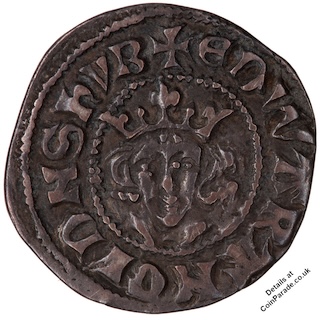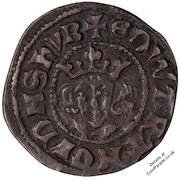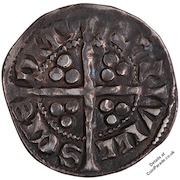
 The 1310 Penny - 1310-1314 Penny Class XI Bury St. Edmunds - Edward II
The 1310 Penny - 1310-1314 Penny Class XI Bury St. Edmunds - Edward IISilver Penny of King Edward II, minted at the Bury St. Edmunds Mint around 1310-1314. Class XI. SCBC 1465, North 1060.
The coins of Edward II are generally as the coins of Edward I with minor variations. Several regional mints were in use at the time. This coin Bury St. Edmunds, diameter 19mm, weight 1.395g.
The Obverse shows a Crowned bust of a King facing. Legend is "+ EDWA R ANGL DNS HYB" (Edward, King of England, Lord of Ireland).
 The Reverse is a long cross design with three pellets (beds) in the angles. Beaded border. Legend "VILL SCIE DMV NDI" (Bury St Edmunds).
The Reverse is a long cross design with three pellets (beds) in the angles. Beaded border. Legend "VILL SCIE DMV NDI" (Bury St Edmunds).Image credit: Museums Victoria
Mintage: Not known
Minted at Provincial mints
More information (monarch, year, mint, country, category) can be found below coin listings.
Below are some coins currently being offered on eBay. As an eBay Partner, We may be compensated if you make a purchase.
List items on:
List items on:
Edward II (1307-1327)
Edward ruled from 1307 until he was deposed in 1327. He had a controversial reign. Sometimes known as Edward of Caernarfon. House of Plantagenet. He was the son of King Edward I and Eleanor, Countess of Ponthieu. Edward II was born in 1284 at Caernarfon Castle, in Wales. In 1308 he married Isabella of France, the daughter of King Philip IV, to help relations between England and France.Much of the controversies of Edward's reign was his friendship with Piers Galveston. Historians are divided whether this was a close friendship or if they were lovers. Whatever, Galveston was arrogant and openly gave verbal abuse to the Dukes and Barons in the court of the King. It made matters worse when the King showed favouritism and bequeathed Galveston with titles. Galveston was exiled a couple of times, but the King brought him back. Galveston made a few insults too many, and the Barons with their powerful private armies, arrested him themselves and executed him.
Edward II had an embarrassing defeat by Robert the Bruce at the Battle of Bannockburn in 1314, when Robert had a much smaller army. Eventually Edward had to make a truce with Scotland, which remained independent.
When his wife Isabella was sent to France to negotiate a peace treaty, she turned against him. Edward had few friends and was forced to relinquish the Crown in favour of his son Edward III in January 1327. Edward II died in the September 1327, probably murdered.
Category: Penny
The Penny is one of the most famous British coins. The coin itself has been around since 600AD and at various times has been struck in silver, copper and bronze. Originally split into halfpennies and farthing, it is now itself the least denomination coin currently in circulation. Made from copper (actually copper plated steel). Originally there were 12 pennies in one shilling and 240 pennies in £1; since decimalisation in 1971 there are 100 new pence in one pound.
Composition: Early pennies were Silver, then Copper, Bronze and Copper coated steel.
Which Mint: Provincial mints
Not all mints are located in a single place. From the Roman days through to the middle ages it was easier to have local moneyers (trusted people who were allowed to mint coins) rather than make the coins centrally and then have the security and logistics problem of distribution.There were often dozens of mints, sometimes all making the same coin. The variations and mintmarks are exciting for numismatists, although sometimes it takes an expert to analyse them.
Most English Provincial Mints began to close after 1279 when the Royal Mint opened The Tower Mint (called so as it was housed at the Tower of London), although some continued working for much longer. The central mint gave the King and the Master of the Royal Mint much more control over the production and quality of English coinage.
Country of Origin: United Kingdom
The United Kingdom (UK) is the Union of England, Scotland, Wales and Northern Ireland. It is often refered to as Great Britain (GBR). It has a long, rich history. The orignal coinage was Pounds, Shillings and Pence but since decimalisation on 15 February 1971, it is £1 = 100p, that is One Pound = 100 pence. The coinage of the UK is also a long history, the Royal Mint being established as long ago as 886AD when coins were hammered. Today there is perhaps 30 billion coins in circulation, and many (numismatic) collectors coins and sets are issued frequently in gold, silver and other metals.








